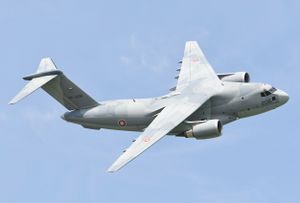Soong Y-2
| Y-2 | |
|---|---|

| |
Role
|
Military transport aircraft |
National origin
|
Monsilva |
Manufacturer
|
Soong Aerospace Company |
First flight
|
26 January 2010 |
Introduction
|
30 June 2016 |
Status
|
In service |
Primary users
|
|
Produced
|
2010–present |
Number built
|
20 |
The Soong Y-2 (宋Y-二) is a mid-size, twin turbofan engine, long range, high speed military transport aircraft developed and manufactured by Soong Aerospace Company. In June 2016, the Y-2 formally entered service with the Monsilvan Air Force (MAF). There are ongoing efforts to sell it overseas to countries such as Gjorka and TBC, with the Gjorkan National Armed Forces currently having 7 in service. The aircraft to supplant and replace the older Soong Y-1 turbofan transport that has been in service since the 1970s.
Contents
Development
After researching foreign aircraft, the Monsilvan Department of Defense concluded that there were no aircraft in production that possessed the capabilities that the MAF required. In response to this need, the MDOD commenced the production of plans to develop an indigenously designed and manufactured transport aircraft. Fortunately, Soong had already requested funding for a domestically built Y-X transport aircraft that was yet to be built, but would meet the requirements that the Air Force were in need of. In 2000, the MDOD funded Soong's planned aircraft model for manufacturing.
The Y-X was developed alongside the F-X, which Soong had also been selected to develop. As a cost saving measure, major airframe parts and system components were shared between the two aircraft. They use a similar basic wing structure, although it is installed at a different sweep angle and dihedral on the two versions, with different high lift devices and powerplant attachments. Common components include the cockpit windows, outer wings, horizontal stabilizer and other systems. Internal shared parts include the auxillary power unit, cockpit panel, flight control system computer, anti-collision lights, and gear control unit. As of 2007, the total cost for the two aircraft has been ¥19.9 billion, which is low compared to other programs.
Several powerplants were considered for the Y-X, including engines built by the Baltanese company, DTB Transportation. In May 2003, DTB's CF6-80C2L1F engine was approved by the company to be manufactured by Soong Heavy Industries in order for use on the Y-X. During the construction of the first prototype, there was an issue with some rivets built by an unknown foreign company. This lead to Soong delaying the roll-out to 2007 in order to determine the origin of the rivets. The origin was never determined, but rivets built by the Monsilva Steel Corporation were used instead on both the Y-X and F-X.
The Y-X was rolled out as the Soong Y-1 on 26 January 2010.
Design
The Soong Y-2 is a long range twin-engine transport aircraft. In comparison with the older Y-1 that it replaces, the Y-2 can carry payloads up to four times heavier and possesses six times the range.
The Y-2 is being developed to meet the following requirements of the Department of Defense: a minimum payload of 26 tonnes, 120 metric ton (264,552 lb 132.275 short ton) take-off weight, ability to takeoff/land on short runways, (Requirement: 500m, almost same as Y-1), a maximum payload of 37,600 kg whilst taking off from a 2,300 m Take-off Field Length at a 141 tonnes (310,851 lb 155.42 short ton) take-off weight, ability to fly international air routes (Requirement: Mach 0.8+; MAF ruled out Y-17 as a candidate by its lower cruising speed. Conventional cargo aircraft cannot cruise at optimum altitude on commercial airroutes because of their lower cruising speed and are often assigned to lower altitude by ATC), in-flight aerial refuelling and forward looking infrared systems.
The Y-2 is powered by a pair of DTB CF6-80C2K turbofan engines. While sharing fuselage components with the Soong F-1, the fuselage of the Y-2's is substantially larger to accommodate a vast internal cargo deck, which is furnished with an automated loading/unloading system to reduce workloads on personnel and ground equipment. The forward fuselage and horizontal stabilizer is made of an internally designed composite material, KMS6115. A tactical flight management system and head-up display is installed to reduce the challenges involved in flying at low altitudes or close to mountainous terrain. The Y-2 is equipped with a full glass cockpit, fly-by-wire flight controls, a high-precision navigation system, and self-protection systems.
Specifications
General characteristics
- Crew: 3: 2 pilots and 1 loadmaster
- Capacity: 32 t limited to +2.5g ; 36 t limited to +2.25g ; maximum payload 37.6 t
- Length: 43.9 m (144 ft 0 in)
- Wingspan: 44.4 m (145 ft 8 in)
- Height: 14.2 m (46 ft 7 in)
- Empty weight: 69,000 kg (152,119 lb)
- Max takeoff weight: 141,400 kg (311,734 lb)
- Powerplant: 2 × DTB CF6-80C2K1F turbofan engines, 265.7 kN (59,740 lbf) thrust each
Performance
- Maximum speed: 920 km/h (570 mph, 500 kn)
- Maximum speed: Mach 0.82
- Cruise speed: 890 km/h (550 mph, 480 kn) / M0.8
- Range: 7,600 km (4,700 mi, 4,100 nmi) with 20 t (20 long tons; 22 short tons) payload
- 5,700 km (3,500 mi; 3,100 nmi) with 30 t (30 long tons; 33 short tons) payload
- 4,500 km (2,800 mi; 2,400 nmi) with 36 t (35 long tons; 40 short tons) payload
- Ferry range: 9,800 km (6,100 mi, 5,300 nmi)
- Service ceiling: 13,100 m (43,000 ft)
- Minimum takeoff distance: 500 m (1,641 ft)